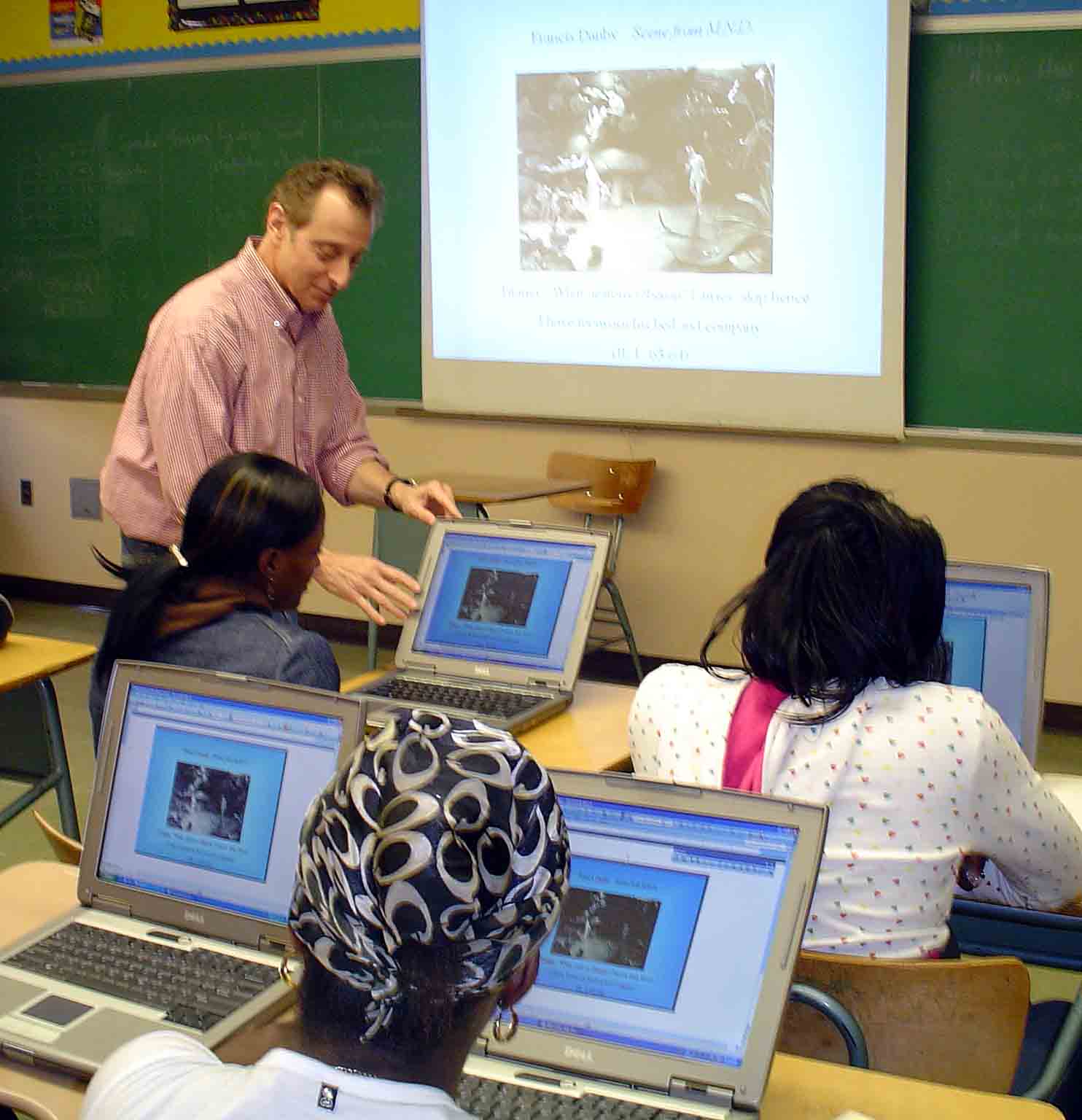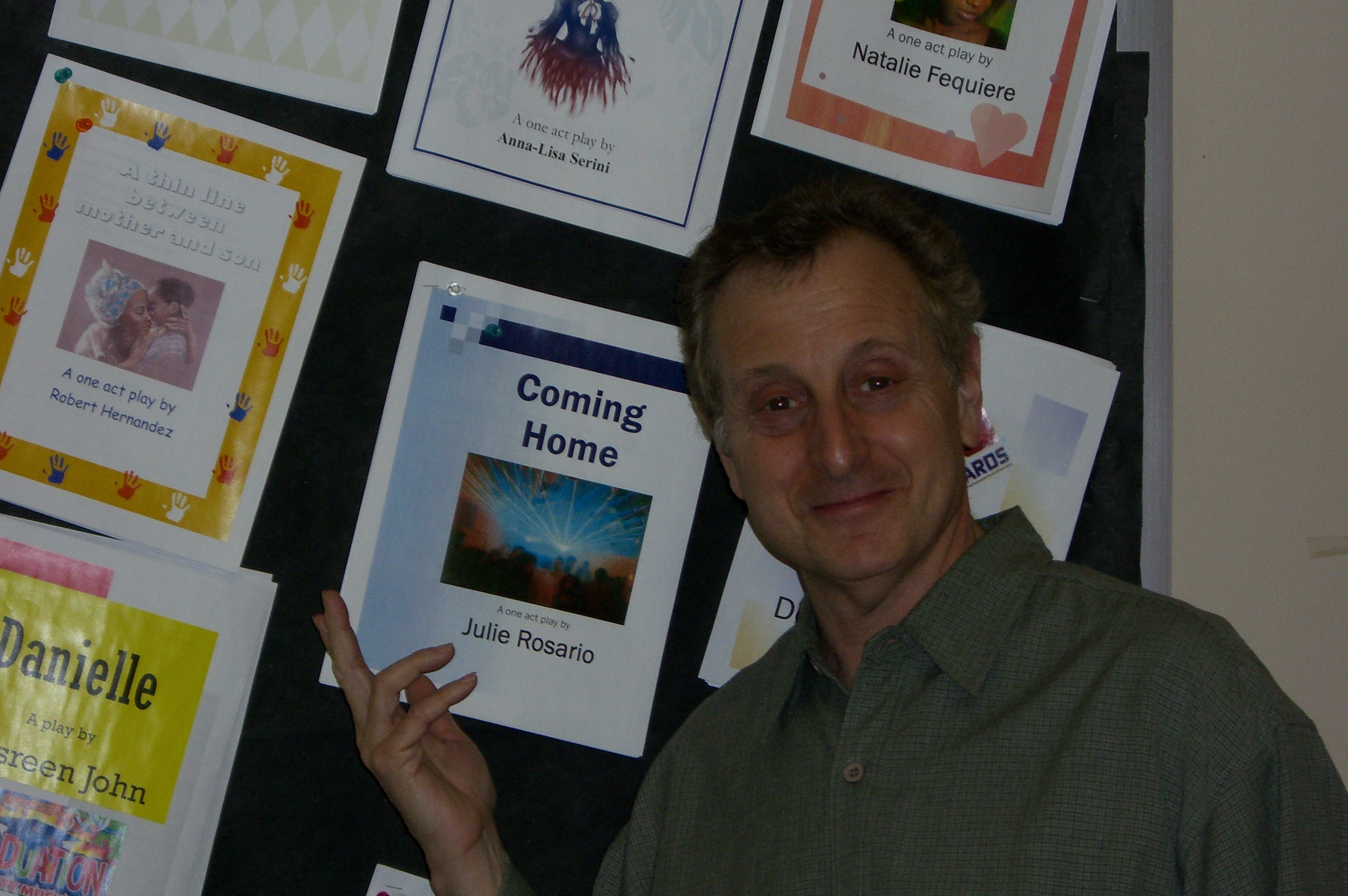 Subject: English Subject: English
Grade Level: 10-12
Materials: Computers with MS PowerPoint and Internet connection; text of Shakepeare's A Midsummer Night's Dream
About: Students study the play by Shakespeare, then research art of the Fairyland characters, primarily in the collections of Emory University and the Tate Museum in London. Students then match paintings to the actual quotes in the play, with act, scene, and line numbers, and develop that into a narrated slide show in PowerPoint.
Students narrate their own PowerPoint slide show featuring the artwork they have researched. They discuss each painting, including why they chose it, what they have learned about the artist who painted it, and how it matches with a plot point in the play.
The unit involves learning a Shakespearean play; mastering techniques in PowerPoint such as slide design, timing, animation, formatting, and layout; and using the Internet as a research tool to learn about paintings and artists.
This project adds a visual dimension to a classic play. It synthesizes technology, art, art history, and, of course, Shakespeare's beautiful text.
| Students develop an appreciation for Shakespeare's use of language, and demonstrate an understanding of the plot points in the play and the traits of the main characters. |
| Students demonstrate a mastery of the fundamentals of PowerPoint. |
| Students show knowledge of the artists who painted the Fairyland characters, and their work. |
| Students demonstrate ability to use the Internet and familiarity with the collections at Emory University and the Tate Museum of London. |
|
|
|
|
|
|
| Students read, write, listen, and speak for information and understanding. |
| 10-12 |
| English |
| Students read, write, listen, and speak for critical analysis and evaluation. |
| 10-12 |
| English |
| Students read, write, listen, and speak for social interaction. |
| 10-12 |
| English |
| Students identify and define the uses and parts of a computer. |
| 10-12 |
| Technology |
| Students know and use technical vocabulary. |
| 10-12 |
| Technology |
| Students understand basic computer operations. |
| 10-12 |
| Technology |
| Students are able to manipulate file basics. |
| 10-12 |
| Technology |
| Students behave responsibly when using computers. |
| 10-12 |
| Technology |
| Students use age-appropriate electronic resources. |
| 10-12 |
| Technology |
| Students create products. |
| 10-12 |
| Technology |
| Students use the Internet. |
| 10-12 |
|
| Students select appropriate technologies for a given project, using appropriate software, such as Word, Publisher, and PowerPoint. |
| 10-12 |
|
|
| Day 1: Writing a Character Analysis of the characters Oberon, Titania and Puck for a children's book |
| Students demonstrate a knowledge of the characters Oberon, Titania, and Puck. |
| Students use language to inform. |
|
|
|
|
| Text of A Midsummer Night's Dream |
| Looseleaf paper and pen |
|
|
|
| Elicit characteristics from students about each of three characters. Focus on physical characteristics and motivations for each character. |
| In groups, have students develop biographies for each of the characters (target audience: children in 4th grade who have never seen the play). |
| Share with class. |
|
|
|
|
|
|
|
|
| Find at least one quote that matches with a character trait you have written about. Match a quote in the text to each character. |
|
| Day 2: Introduction to PowerPoint |
| Mastery of creating a file |
| Mastery of slide design |
| Creation and manipulation of text boxes |
| Creating a title |
|
|
| Students open program, create file, and save. |
| Students are taught about views and task pane. |
| Students create slide design for title slide. |
| Students learn to place title in text boxes and manipulate the boxes and the content within them. |
| Students create title slide content, title, and byline. |
| Students are instructed to review the Shakespeare Illustrated site at Emory University. |
| Students select one painting for title slide and save work. |
|
|
|
|
| Read about Richard Dadd and his place in Victorian Art in any encyclopedia; write down something you learned and the source of that information. |
|
| Examination of PowerPoint slide show |
|
| Day 3: Matching art with quotes from text |
| Demoinstrating a knowledge of the Fairyland art |
| Through critical analysis, matching artwork to plot points in the play, and suitable quotes |
| Copying and pasting into slide show |
| Using picture tool bar; cropping and re-sizing pictures |
|
|
| PowerPoint software |
| Internet access |
| Text of A Midsummer Night's Dream |
|
|
| Return to Emory University site and review works. |
| Sort pictures into chronological order. |
| Copy and paste picture into second slide in show. |
| Use picture toolbar to re-size and crop. |
| Place artist, title of picture, and year painted into title box of slide. |
| Find quote that goes along with picture. |
| Place quote underneath picture. |
| In notes view, write why you chose this picture. |
| Save your work. |
|
|
| Students research and write bio of Victorian Art. |
|
| Informal assessment of students' PowerPoint work as teacher walks from computer to computer |
|
| Day 4: Developing the slide show |
| Matching pictures to chronological plot points and quotes |
| Animation and slide transitions |
|
|
|
|
| PowerPoint software |
| Internet access |
| Text of A Midsummer Night's Dream |
|
|
| Students choose pictures for their five-picture slide show. |
| Students cut, paste, crop, and re-size pictures. |
| Students set animations transitions and slide designs for each slide. |
| Students write matching quote in text box below picture. |
|
|
|
|
|
|
|
| Research and write a biography of Joseph Noel Paton. |
|
| Question: Why do you think Victorian England embraced the Fairyland characters of Elizabethan England? |
|
| Day 5: Presentation of Slide Show |
| Mastery of public speaking |
| Mastering tecnology of presenting a slide show |
| Relating artwork to text |
|
|
|
| Projector |
| Computer |
| Email access |
|
|
| Students email teacher their projects as attachments, which are then saved. |
| Students present their shows, advancing slides on the computer. |
| Students are peer-graded based on content and delivery. |
|
|
|
|
|
|
|
|
|

Joseph Zwerling
jzwerli@schools.nyc.gov
Brooklyn Comprehensive Night High School
6565 Flatlands Ave, 4th Floor
Brooklyn, NY 11236
Mr. Zwerling has been teaching English in Brooklyn Comprehensive Night High School since 1993. During this time, both he and his students have been honored with awards. In 2002, Mr. Zwerling won an award from the Bertelsmann New Media Workshop for Best Lesson Plan on 9/11, and in 1997 he received an award for Excellence in Teaching from the District Superintendent. He has also had essay award winners: in the last two years, his students have won one city-wide and two borough-wide awards in the United Way Essay contests. Mr. Zwerling holds a Masters in English and an undergraduate degree in Speech and Theater from Brooklyn College. He enjoys teaching playwriting, public speaking, and dramatic literature; and was among the first to infuse technology into the classroom. His unit on a Midsummer Night 's Dream includes student slide shows in MS PowerPoint based on "Fairyland" art primarily of the 19th and 20th Centuries currently available at collections online. Before teaching, Mr. Zwerling had been a performer for 15 years, principally as a mime, and the highlight of his career was performing at Carnegie Hall in 1983 with the St. Lukes Chamber Orchestra. He hopes to continue his innovative teaching, for it allows him to bring both his expertise as an English teacher and his talent as a performing artist into the classroom.
Important documents for this lesson plan.
|